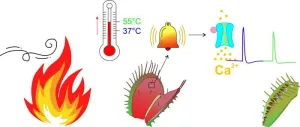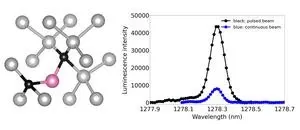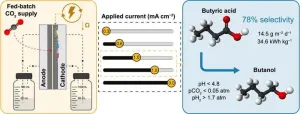(Press-News.org) The Venus flytrap can survive in the nutrient-poor swamps of North and South Carolina because it compensates for the lack of nitrogen, phosphate and minerals by catching and eating small animals. It hunts with snap traps that have sensory hairs on them. If an insect touches these hairs two times, the traps shut and digests the prey.
In its location in the swamp, the carnivorous plant is often not visible because it is overgrown by grass. In summer, the grass dries up. Then it can catch fire from the frequent lightning storms typical of North Carolina – a dangerous situation for the Venus flytrap.
How does the plant protect its vital snap traps and sensory hairs from fire? Biophysicists Professor Rainer Hedrich and Dr. Shouguang Huang from Julius-Maximilians-University (JMU) Würzburg in Bavaria, Germany, have found out: The Venus flytrap uses special heat receptors in the sensory hairs for this purpose, as the researchers report in the journal Current Biology.
Carolina bushfire imitated in Würzburg
"To find out how the flytrap behaves when burning a covering of dry grass, we transplanted plants with open snap traps from the greenhouse to the open field in the JMU Botanical Garden and covered them with hay," says Rainer Hedrich. "Then we set fire to the hay at one end and forced it to spread to the other end with a fan".
After the fire, the plants had closed all the traps. Some traps showed no damage, others appeared to be burnt. After a few days, all undamaged traps were open again and working – they snapped after touching their sensory hairs.
Hot air makes the fly traps snap
"We had only recently elucidated the stimulus-response chain during trap closure after wounding. Now the question arose whether the traps might already react to the heat wave in the run-up to a fire," says Hedrich.
The JMU researchers were correct in their assumption: a hot air blower directed at the trap was sufficient to cause the trap to close. Next, the scientists conducted heat experiments under controlled laboratory conditions.
Heat sensor activates at 37 and 55 degrees Celsius
The catching organ of the Venus flytrap consists of two leaf halves. Dr. Shouguang Huang brought the outside of one half of the trap into contact with a Peltier element – with this electrothermal transducer, he was able to selectively set different temperatures on the trap through controlled current supply.
He found that when a local leaf temperature of 37 degrees Celsius was exceeded, the heated area of the trap produced an electrical impulse, an action potential that spread across both halves of the trap. "When the temperature increased further to 55 degrees Celsius, a second action potential was triggered and the trap snapped shut," Shouguang said.
But the trap's reaction at 37 and 55 degrees Celsius only kicked in when temperatures increased abruptly, as in a rapid heat wave. If the temperature rose only slowly, as on hot summer days, the traps did not react.
"In contrast to humans, the heat sensor of the carnivorous plant does not jump when the body temperature is exceeded, but it reacts to the speed of the temperature change," says Hedrich.
By measuring the temperature rise on its surface and closing its traps in a fraction of a second, the flytrap's sensory hairs remain protected from burns. The damp marshy ground further protects them from excessive heat and burns. This allows it to continue hunting for animal food after a fire.
The heat sensor is located in the sensory hairs
Each half of the trap has three sensory hairs that are highly sensitive to touch and generate action potentials. The action potentials are generated at the base of the hairs. There, ion channels that get activated by touch allow calcium to flow into the cells. This calcium signal is the trigger and at the same time an integral part of an action potential. Heat jumps cause the same calcium-dependent electrical events in the sensory hairs as touch.
"To track the calcium signal, we used flytraps that carry a genetically encoded calcium sensor inside them," Hedrich says. When the cellular calcium levels increase, this sensor begins to fluoresce. "We were quite amazed that when the heat was applied, a sensory hair glowed first," he said. "This shows that the hairs operate as touch and heat sensors at the same time," Hedrich concludes.
Focus on calcium channel from the OSCA family
"Currently, we are pursuing the hypothesis that a calcium channel is an integral part of the heat sensor, or even the sensor itself," the researchers said. If this is true, a type of membrane-bound temperature sensor would have been discovered that is still completely unknown in plants.
So far, research knows calcium channels from the so-called OSCA family, which can be activated mechanically and osmotically. "In the future, we want to test whether there are also OSCAs in the sensory hairs of the Venus flytrap that are switched on by the supply of thermal energy, and which of their protein areas respond to mechanics and which to heat."
END
Heat sensor protects the Venus flytrap from fire
2023-08-22
ELSE PRESS RELEASES FROM THIS DATE:
Cleveland Clinic-led team awarded $2.8 million to translate cancer cell evolution research to clinical care
2023-08-22
The National Institutes of Health recently awarded Cleveland Clinic’s Jacob Scott, M.D., D.Phil., and collaborators $2.8 million to translate research on how cancer cells evolve and compete into patient care. The project aims to move previous advances done in vitro closer to clinical reality by developing computer and preclinical models side-by-side, a significant step in the fight against multidrug-resistant cancers that are responsible for more than 90% of cancer deaths.
This is a milestone for ...
Digital real estate listings with more photos, descriptions earn higher sale prices
2023-08-22
AMES, IA — Buying a home is a time-consuming process, in part because it requires balancing financial realities with a long checklist of expectations and desires. People care about a solid foundation and certain number of bedrooms. But a property’s curb appeal, neighbors and proximity to work or good schools also matter.
For most house-hunters in the U.S., setting up filters and scrolling listings on Zillow has become a crucial first step.
“Digital real estate platforms like Zillow help people see what’s available, ...
Can sound waves help people quit cocaine? Cutting-edge clinical trial focuses in
2023-08-22
Pioneering researchers at UVA Health are testing whether focused sound waves can help people overcome cocaine addiction, a growing problem across the nation.
The scientists have launched a clinical trial, believed to be the first of its kind in the world, to test whether low-intensity focused ultrasound can help reprogram brain cells to reduce the desire for cocaine. The noninvasive approach focuses sound waves on a portion of the brain called the insula, thought to play a critical role in multiple forms of addiction. If the trial is successful, it could pave the way for an important new tool to treat addiction in general.
“This ...
Innovative breakthrough in sustainable chemical production
2023-08-22
Carbon capture and utilization (CCU) technologies are crucial for addressing climate change while ensuring economic viability. MES has emerged as a promising approach for CO2 reduction to biofuels and platform chemicals. However, the industrial adoption of MES has been hindered by low-value products like acetate or methane and high electric power demand.
In a new study recently published on 26 July 2023, in the journal Environmental Science and Ecotechnology, researchers from University of Girona conducted a study that focused on electrically ...
Detroit Public Schools Community District staff complete CPR training and education
2023-08-22
DETROIT, August 22, 2023 — Today, Detroit Public Schools Community District teachers and coaches completed either the American Heart Association’s Heartsaver® CPR AED (automated external defibrillator) course, which provides the highest quality evidence-based training in the lifesaving skills of CPR, as well as the appropriate use of an AED, or Hands-Only CPR education. Adding lifesavers to the chain of survival in the Detroit community through CPR training and education is a priority for the Detroit Lions Foundation.
“We are honored to use our platform to further bring awareness and education to our community ...
Groundbreaking Ultracompact Spoof Surface Plasmon Sensing System Revolutionizes Gas Detection with Smartphone Integration
2023-08-22
A team of researchers from Southeast University of China has developed a cutting-edge ultracompact sensing system that leverages the power of spoof surface plasmon resonance (SSPR) technology to enable adaptive and accurate gas detection using a smartphone. The research article detailing this breakthrough, titled "An Ultracompact Spoof Surface Plasmon Sensing System for Adaptive and Accurate Detection of Gas Using a Smartphone," has been published in the prestigious journal Engineering.
Traditional dielectric sensing methods often suffer from signal fluctuations, resulting in reduced sensitivity and accuracy. In response to the growing demand for precise gas detection in ...
Unintended consequences: Terror attacks cause long-term acceptance of targeted communities
2023-08-22
Violent actions intended to provoke opposition to particular communities may paradoxically lead to lasting acceptance, according to a study. On March 15, 2019, a far-right extremist killed 51 Muslims in Christchurch, New Zealand. Immediately following the attacks there was a noticeable increase in public acceptance of the Muslim minority in the country. But was this acceptance sustained? To address this question, Joseph Bulbulia and colleagues used years of data from the New Zealand Attitudes and Values Study, a national longitudinal study. The author’s goal was to estimate the anticipated level of Muslim acceptance if the attacks had not occurred. These ...
Uranium signatures in turtles and tortoises near nuclear testing and waste sites
2023-08-22
The shells of turtles, tortoises, and sea turtles keep growing as long as the animals live—and some of them live a remarkably long time. Cyler Conrad and colleagues analyzed the shells of five specimens from areas that potentially accumulated anthropogenic uranium through nuclear fallout and/or waste. Unusual uranium signatures were found in a green sea turtle from Enewetak Atoll in the Republic of the Marshall Islands, a desert tortoise from southwestern Utah near the Nevada National Security Site (formerly known as the Nevada Test Site), a river cooter from the Savannah River Site in South Carolina, and a box turtle from Oak Ridge, Tennessee, ...
Australia experiences intense surge in Strep A cases, similar to northern hemisphere wave
2023-08-22
Australia has experienced an intense surge in severe Strep A cases, similar to the northern hemisphere wave, despite differences in seasons and circulating respiratory viruses, according to a new study.
The national research project, involving researchers from Murdoch Children’s Research Institute and published in The Lancet Regional Health - Western Pacific, highlighted how the unseasonal increase in case load across the southern hemisphere adds to the need for a safe and effective vaccine against Strep ...
Coffee offers performance boost for concrete
2023-08-22
Engineers in Australia have found a way of making stronger concrete with roasted used-coffee grounds, to give the drink-additive a “double shot” at life and reduce waste going to landfills.
Lead author Dr Rajeev Roychand from RMIT University said the team developed a technique to make concrete 30% stronger by turning waste coffee grounds into biochar, using a low-energy process without oxygen at 350 degrees Celsius.
“The disposal of organic waste poses an environmental challenge as it emits large amounts of greenhouse gases including methane and carbon dioxide, which contribute to climate change,” ...









